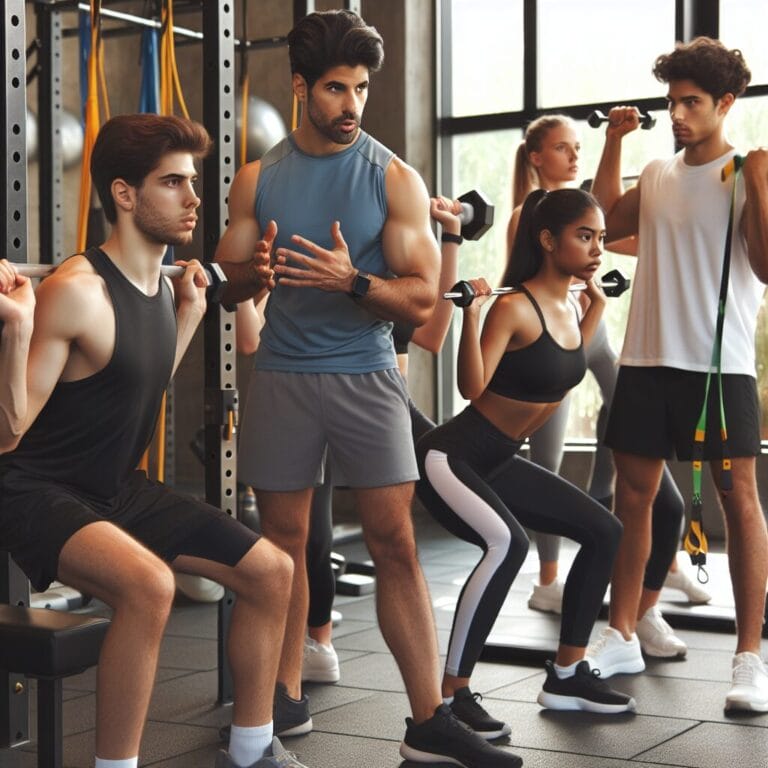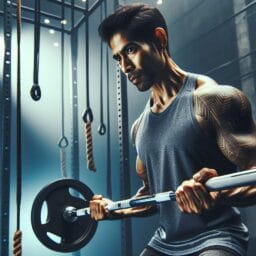
Maximizing Potential: The Ultimate Guide to Strength Training for Youth
Table of Contents
- Introduction
- Debunking Myths
- Age-Appropriate Strength Training
- Designing a Strength Training Program
- Core Exercises for Youth Strength Training
- Nutrition and Recovery
- Injury Prevention and Safety
- Psychological Aspects
- Involving Parents and Coaches
- Measuring Progress and Success
- Conclusion
- Frequently Asked Questions
Introduction
Hey kids, guess what? Strength training isn’t just for grown-ups! Yep, you heard it right. Young athletes like you can get super strong and have a blast doing it. Imagine having your own superhero muscles to run faster, jump higher, and throw farther—cool, right? Well, that’s what strength training does. It’s like leveling up in a game but in real life!
Here’s the scoop—using weight machines or doing exercises with your body weight can help make your muscles mighty. And get this; even young people with cerebral palsy are finding out how awesome strength training is for them too. Doctors who know all about kids’ health say it’s A-OK as long as you do it safely.
Now, you might think lifting weights could hurt your growth plates—that’s where your bones grow. But no worries! The smarty-pants exercise scientists say if you learn the right way to lift from a certified coach and stick to nonconsecutive days (like Monday then Wednesday), you’re good to go.
And check this out: those hamstring training drills or martial arts moves aren’t just fun; they’re making your legs strong and bendy—full range coolness! Plus, did you know some sports stars wear weighted vests to build even more muscle power? Just don’t rush into heavy stuff without a green light from a pro.
So next time you’re at practice or playing catch in the yard, remember every hop, skip, and kick is helping you become an amazing athlete. Keep moving, stay fit, and always listen to coaches so every training session turns into a winning move for your muscles!
Debunking Myths
Did you know that many folks worry strength training could stunt a young athlete’s growth? Well, rest easy – science has busted that myth! Studies show that when kids lift weights the right way, it actually helps their bones become tougher and stronger. So, if you’re a sporty kid or a super-active teen, strength workouts are like a secret weapon to help your body grow big and healthy.
Now, let’s talk safety because nobody wants ouchies while getting buff. The real deal is that pediatrics recommends strength training as safe for youth athletes ages 7 and up – yep, even prepubertal boys and girls. But – and this is a biggie – it’s got to be done with proper moves to keep those growing bodies happy. That means checking in with an exercise physiologist or certified strength coach who can teach the right techniques for each muscle-mighty move.
Don’t fall into the trap of thinking it’s all about running and jumping either. While cardio is awesome for heart health, mixing in some hamstring training drills or martial arts training keeps your muscles guessing and growing in all kinds of ways. It leads to neural adaptations (fancy term for brain-muscle communication), which means better coordination and explosive force production endurance – fancy words for being able to run faster, jump higher, and play harder without tiring out!
So grab those weighted vests (if your coach gives the thumbs up!), join a fun strength program, and enjoy building up not just muscle power but also confidence at every successful training session program. Remember, with great power comes great responsibility—use your newfound strength wisely on your journey to becoming an amazing young athlete!
Age-Appropriate Strength Training
Strength training for young athletes is like adding a turbo boost to their sports performance—it’s all about tapping into those physical capacities they didn’t even know they had! When it comes to tailoring strength programs for kids and teens, it’s important to consider each athlete’s stage of growth. This isn’t a one-size-fits-all situation; what works for prepubertal boys may not be the best approach for adolescent weight lifters who are closer to reaching skeletal maturity.
For the little champs, typically around 7 to 10 years old, the focus should be on mastering movement fitness with bodyweight exercises and light resistance training. It’s like building the base of a pyramid—getting those fundamentals rock solid before piling on anything heavier. As young people shoot up in age and size, they can gradually shift gears towards more structured strength programs that improve strength across a full range.
Proper technique? Non-negotiable! An exercise physiologist or certified strength coach should always oversee training sessions, guiding young athletes through hamstring training drills and ensuring weighted vests are used appropriately—if at all. They’re the guardians against improper technique, which can lead to injuries.
What’s super cool is that as adolescents improve their muscle mojo through these well-designed programs, their neural adaptations kick in. That means their brains get better at telling their muscles how to fire up quickly and efficiently—hello explosive force production endurance! So when youth athletes ages 11-14 hit the field or court, they’re not just flexing muscle—they’re showcasing serious agility and power that’s been fine-tuned by science-backed strength training safe practices.
And let’s not forget about our friends with cerebral palsy or other special considerations. Pediatrics recommends inclusive fitness regimes where every young athlete gets to experience the victories of a successful training session program tailored just for them. Strength trained youngsters aren’t just building biceps, they’re creating resilience—a superhero trait if there ever was one!
All this goes to say: Youth strength training benefits explained? It’s about crafting an epic journey from playful pliability to poised power—all while keeping those precious growth plates perfectly peachy!

Designing a Strength Training Program
Have you ever wondered how young athletes can soar to new heights in their sports without getting bored or burnt out? It’s all about setting goals that shine as bright as the stars and finding a harmony between strength training and other physical fun. Picture this: an aspiring soccer star not only kicks balls into nets but also follows a strength training program designed just for them—one that grows tougher as they grow stronger, thanks to the nifty idea called progressive overload. This means the exercises get a bit more challenging step by step so muscles don’t snooze on the job!
Now, let’s pump up the excitement even further! A round of applause for variety—it’s the super spice that keeps training tastier than your favorite pizza topping. Young athletes should mix it up with a combo platter of martial arts training for some kick-butt moves, weight machines to feel like rock stars, and maybe toss around medicine balls like they’re hot potatoes—all under the watchful eyes of certified strength wizards (you might call them coaches) who make sure those lifts and lunges are spot-on perfect.
But wait—there’s more! While young sports kids are mastering hamstring training drills and trying on weighted vests for size (only if their coach says “thumbs up!”), they’re also learning an epic life lesson: balance is key. Juggling school, playdates, and piano lessons with their new superhero workout routine teaches these mini-champions the power of a well-rounded day.
And what about youth athletes ages 11-14? They’re in a special club called ‘growing up fast,’ where bodies change quicker than fashion trends. That’s why their strength program is tailored to be as flexible as a ninja—ensuring these adolescent players improve strength while respecting their youth-growth maturation journey.
So, next time you see a young athlete swinging from monkey bars or scoring goals, know there’s science-backed magic at work behind those smiles. Strength trained youngsters aren’t just building biceps—they’re sculpting success with every rep and run under the grand sky of endless possibilities!
Core Exercises for Youth Strength Training
Hey there, sporty kids! Let’s power up your play with some cool moves to build muscle and might. Starting a strength training program can be as fun as swinging on the jungle gym, but instead of monkey bars, we’re talking about bodyweight exercises – think superhero squats and power push-ups – perfect for young athletes just beginning their strength quest. And guess what? These nifty exercises improve strength without needing any fancy equipment!
Now, ready to add some extra oomph? Free weights and resistance bands are like the secret gadgets of the fitness world. They come in all shapes and sizes, making them super handy for youth athletes ages 11-14 looking to level up! But hold on – before you start swinging those weights around like medieval knights, let’s chat safety tips: stand tall with good posture, move smoothly like a ninja avoiding detection, and never forget that control is way cooler than speed.
And here’s some advice straight from the pros – certified strength coaches insist that learning how to use equipment safely is key. Whether it’s weight machines designed for healthy children or simple gear like resistance bands tailored for sports kids’ needs – using them right means no bad surprises during your training session. Plus, these tools help work out different muscles so you’ll be ready for any adventure that comes your way!
So grab those resistance bands, team up with an exercise physiologist or a coach who knows their stuff about youthful training magic, and go conquer those goals. With every stretch and lift, you’re not just getting stronger; you’re growing into amazing athletes who know how to play it safe and smart! Remember (but not too much!), when it comes to building strength – you’re in this game for fun AND wins!
| Exercise Type | Focus Area | Equipment | Age Recommendation | Safety Tips |
|---|---|---|---|---|
| Bodyweight Exercises | Building Muscle and Strength | None | Beginners | Ensure good posture, move smoothly |
| Superhero Squats | Legs, Glutes, Core | None | All ages | Control is more important than speed |
| Power Push-Ups | Chest, Shoulders, Triceps | None | All ages | Maintain proper form to prevent injury |
| Free Weights | Overall Muscle Development | Dumbbells, Barbell | 11-14 | Use equipment safely, proper technique |
| Resistance Bands | Strength, Flexibility | Resistance Bands | All ages | Get guidance from a coach or exercise physiologist |
| Weight Machines | Targeted Muscle Groups | Weight Machines | Healthy Children | Learn proper use to avoid injury |
Nutrition and Recovery
Picture this: a team of young athletes running faster, leaping higher, and playing harder than ever before – all thanks to the power-packed punch of a well-rounded strength training program. But muscles aren’t just powered by exercise; they’re fueled by what these sports kids put on their plates. Just like a race car needs top-quality gas to zoom around the track, young people need yummy, healthy foods to feed their physical capacities.
Hydration is another champion in the strength training game. Think of water as your body’s personal assistant, working overtime to make sure everything runs smoothly. Before hitting the weight machines or donning those weighted vests for hamstring training drills, sipping water is like prepping your inner superhero for action! Continuing to drink up during and after those sweat sessions at the gym keeps energy levels high and recovery times low.
And when it comes to rest and recovery – that’s where true muscle magic happens. It’s not just about pushing hard but also knowing when to hit the pause button. Catching enough ZZZs gives those growing bodies time to repair and get even stronger – kind of like giving your muscles a mini-vacation. So while resistance training boosts those biceps, dreamland is where adolescent weight lifters’ growth plates whisper thank-you notes for taking it easy every now and then.
In the bustling world of youth sports, remember (but not too often!), it’s not only practice that makes perfect – it’s also munching on good grub, guzzling gallons of H2O, and getting gobs of glorious sleep. These are the unsung heroes behind every successful training session program, making sure our future sports stars are as health-smart as they are strength-trained!

Injury Prevention and Safety
Hey future champs, let’s chat about something super important that hasn’t been spotlighted yet: warming up and cooling down! These are like the bookends to your strength training story, keeping everything neat and tidy so no injuries mess up your sports adventure. Before young athletes hit those weight machines or show off in martial arts training, a warm-up routine is like whispering a secret code to their muscles, saying “Get ready for some action!” It’s about getting the blood pumping and prepping those joints for some serious moves.
And after nailing those hamstring training drills or flaunting skills with resistance bands, it’s time to chill out – literally! Cooling down is kind of like giving your body a high-five for being awesome. It helps bring everything back to normal—heart rate, breathing—all that good stuff. Plus, it’s a chance to stretch out and make sure those growing muscles stay loose and happy.
Now let’s talk teamwork because safety in strength training is a big deal. Spotting buddies are like superheroes; they’ve got each other’s backs when trying new exercises or adding more weight. And coaches? They’re the guardians of the gym galaxy—always watching to ensure nobody’s using improper technique with heavy resistance training or forgetting their weighted vests!
Overuse injuries can sneak up like pesky villains, but here’s how you dodge their tricks: Mix it up! Instead of doing the same ol’ routine every day (yawn), throw in some variety for those muscles—and your brain too. This keeps things interesting and gives muscle groups a break.
So remember (but don’t say it too often!), keeping workouts safe is just as epic as setting new personal bests. When youth athletes tackle each session with smarts—warming up, cooling down, hanging with spotting pals—they’re winning at more than just sports; they’re acing life lessons in health and fitness!
Psychological Aspects
Let’s shed some light on a superpower not many people talk about when it comes to strength training for young athletes – the incredible boost in confidence and motivation! Picture this: a kid starts a strength training program, a bit unsure at first. But then, they lift that weight or master those martial arts moves they’ve been practicing. That right there? It’s like a spark that lights up their whole world! They walk taller, tackle challenges head-on, and shine brighter in everything else they do.
However, even superheroes face hurdles. In the competitive whirlwind of youth sports, managing expectations can be tougher than the heaviest weights. But here’s where the magic of positive reinforcement plays its part. When coaches and parents cheer from the sidelines—not just for victories but also for effort—that’s when young athletes really flourish.
Imagine how amazing it feels to hear “Great job!” after nailing those hamstring training drills or adding an extra rep to their routine. This isn’t just about building muscle; it’s crafting resilience and perseverance within these budding champions. With constructive feedback guiding them through each training session, young players learn more than physical skills—they learn life lessons that shape who they become both on and off the field.
So as these youngsters pursue their athletic endeavors with weighted vests and resistance bands in tow, it’s not just about becoming stronger physically—it’s about growing into confident individuals ready to leap over life’s hurdles with a winning smile!
Involving Parents and Coaches
Strength training may sound super serious, but for young athletes, it’s a ticket to an adventure where they learn as much about lifting weights as they do about lifting each other up. Picture this: a gym where every young power-lifter not only chases their own dreams but cheers on their buddies too. That’s because behind every successful training session program is a team of grown-ups – parents and coaches – who understand that strength isn’t just measured in muscle size, but also in the support shared between teammates.
Creating a positive vibe in the gym starts with adults setting the stage. When mom or dad knows all about how neural adaptations can boost explosive force production endurance, or why pediatricians recommend certain exercises for kids with cerebral palsy, they’re more than just cheerleaders; they’re informed allies ready to help youngsters navigate the path to being both healthy children and strong athletes.
But here’s the real scoop: when coaches are more like Yoda than drill sergeants – guiding with wisdom, kindness, and high-fives for effort over perfection – that’s when magic happens. They’re not just teaching hamstring training drills or the safe use of weight machines; they’re showing young people how to respect their growing bodies and believe in their burgeoning physical capacities.
In this environment where encouragement reigns supreme and knowledge empowers every move, young athletes learn that strength comes in many forms. It grows from good technique on nonconsecutive days at the gym, it thrives on proper nutrition and restful sleep, and yes, it even blossoms through laughs shared over awkward first attempts at martial arts moves. This is the full range of youth strength training benefits explained – where sports kids don’t just lift weights; they elevate each other and themselves to new heights.
Measuring Progress and Success
Alright, future sports stars and their cheering squads, let’s zoom in on something that’ll make your strength training program even cooler. Sure, watching muscles grow is awesome, but have you noticed other super changes? Like maybe you’re not just stronger—you’re also the first to give a high-five at practice or the one who never gives up when drills get tough. That’s because strength training isn’t just about biceps; it’s like a secret school for learning grit, teamwork, and being a good sport.
Now, how do we keep track of all this awesomeness? Easy-peasy! Coaches can set up fun challenges—like who can do the most martial arts moves without getting tangled up or who rocks those hamstring training drills with superhero speed. Each challenge helps young athletes see how far they’ve come—not just in strength but also in discipline and working together.
And here’s some wisdom from the pros: as kiddos grow and crush their goals, sometimes what worked before might need a tweak or two. Maybe those weighted vests need an extra pound (only if coach says so), or perhaps it’s time for heavier resistance training (with proper technique, of course). It’s all part of growing up strong and smart.
So while parents cheer from the sidelines, remember that every push-up and every leap isn’t just crafting mighty muscles—it’s shaping mini-champions into leaders who know winning is more than crossing finish lines first; it’s about lifting each other up too!
Conclusion
Hey, did you know that when young athletes get their groove on with strength training, it’s like unlocking a treasure chest of awesomeness? They’re not just prepping for big games; they’re revving up brainpower! That’s right—strength training goes beyond building muscles; it fires up those neural connections making brain-muscle chats super speedy. This means quicker reflexes in tag or acing that kickflip on the skateboard. Plus, for kids facing challenges like cerebral palsy, strength programs fine-tuned by exercise physiologists can work wonders, boosting what docs call ‘motor skills.’ So whether lifting weights, mastering martial arts moves, or rocking resistance bands under the sharp eye of certified coaches, these mini-athletes are shaping brains and brawn together!
And here’s a cool kicker: pairing strength sessions with puzzles and schoolwork could make homework as easy as pie. After all, pediatrics recommends active bods for healthy minds. When those neurons fire off during hamstring drills or balancing in weighted vests, they’re also getting ready to conquer math problems. So young champs everywhere, keep flexing those muscles and neurons for peak performance in sports and smarts!



